Maritime Satellite Communications Market Size
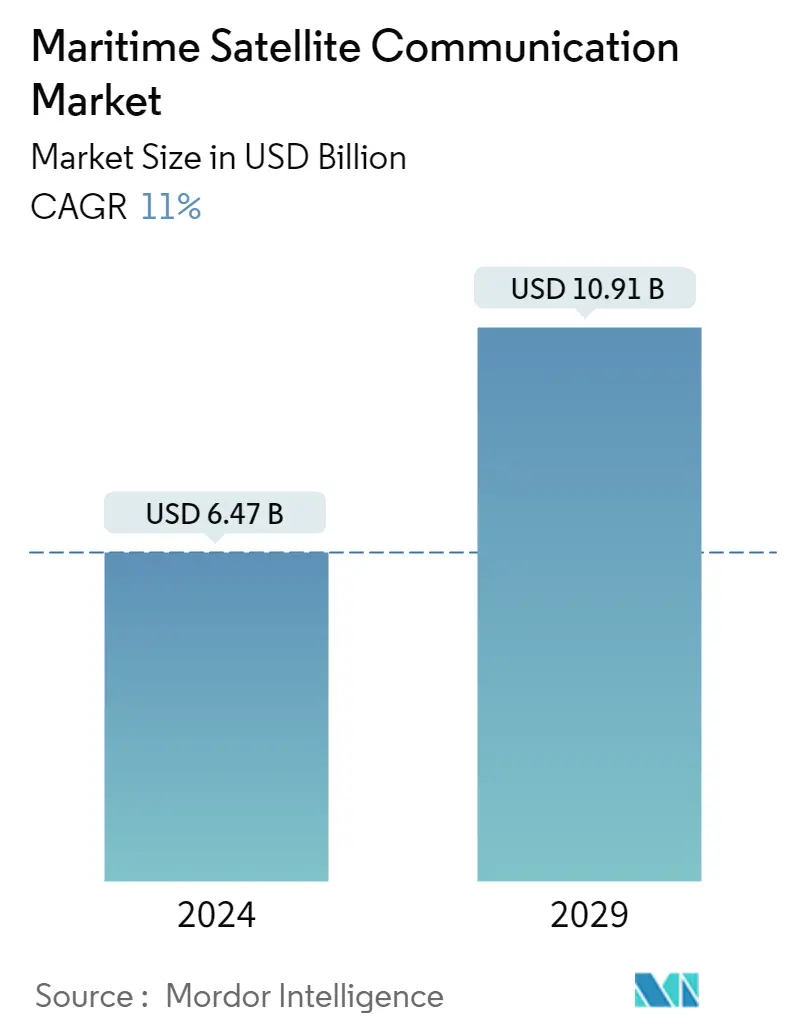
| Study Period | 2019 - 2029 |
| Market Size (2024) | USD 6.47 Billion |
| Market Size (2029) | USD 10.91 Billion |
| CAGR (2024 - 2029) | 11.00 % |
| Fastest Growing Market | Asia-Pacific |
| Largest Market | North America |
Major Players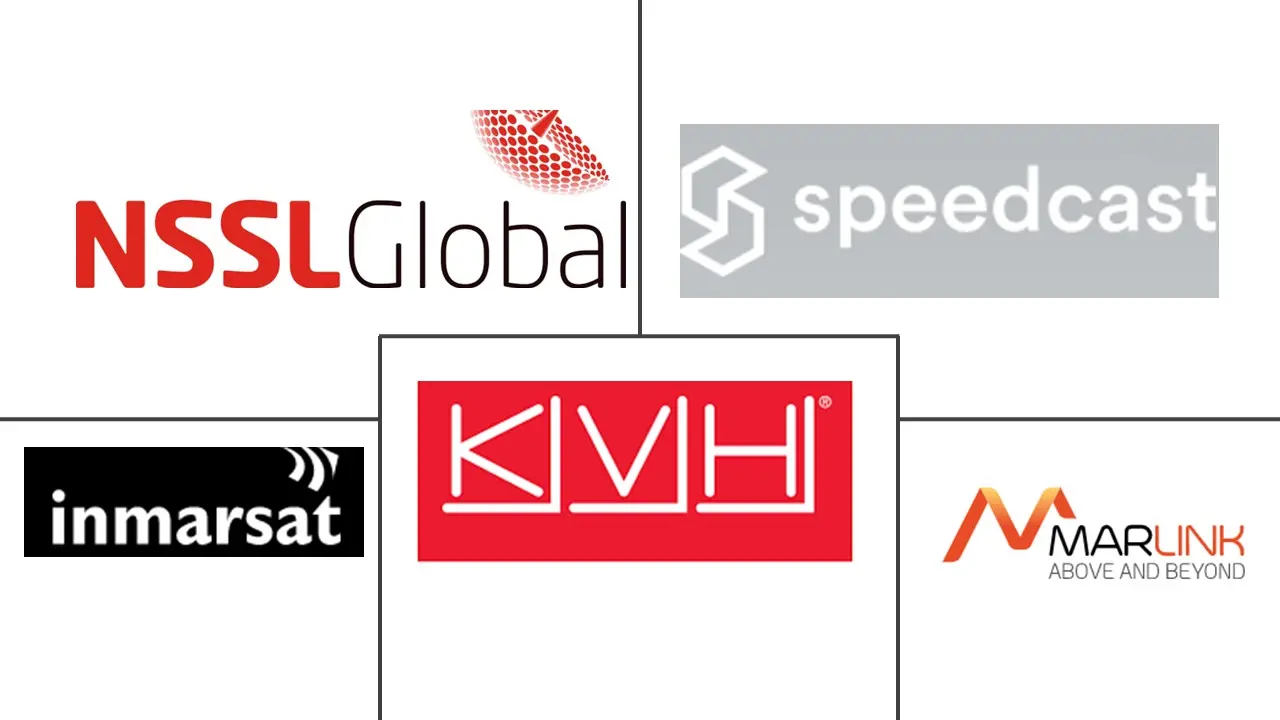
*Disclaimer: Major Players sorted in no particular order |
Need a report that reflects how COVID-19 has impacted this market and its growth?
Maritime Satellite Communications Market Analysis
The Maritime Satellite Communication Market size is estimated at USD 6.47 billion in 2024, and is expected to reach USD 10.91 billion by 2029, growing at a CAGR of 11% during the forecast period (2024-2029).
The primary market growth drivers include rising demand for broadband connections, VSAT connectivity, and high-throughput satellites to enable cloud and IoT applications. According to the Department of Telecommunications (India), in 2023, the total number of internet connections in India reached close to 851 million. The connectivity has almost tripled in the past few years, compared to 302.33 million connections.
- The ability to track cargo and ships worldwide is made possible by satellite communication systems. VSAT terminals are communication instruments that enable text, audio, and video data transmission and reception over satellite-based broadband internet assistance. These terminals are geostationary satellites on the Ku, Ka, and C bands. Service providers would require even greater capacity, performance, coverage, and flexibility to meet the maritime industry's changing needs, where end users have a wide range of communication needs. Additionally, they must be able to expand networks to meet consumer demands swiftly. Customers need help using satellite solutions due to the growing use of maritime satellite technologies.
- The rising demand for applications such as audio broadcasting and voice communications in end-user industries is studied to propel the growth of the satellite communication industry. For instance, in March 2023, Tata Communications launched a new cloud-based application, Jamvee, with integrated voice calling and messaging capabilities for enterprises. With flexible plans for voice calling and data roaming, Jamvee is a cost-efficient solution for the employee collaboration needs of enterprises.
- Crew welfare is made possible by digitalization's quick connectivity for VoIP conversations, messengers, and video conferencing. Smaller ships typically need more room or space for an expensive satellite communications setup, while large ships are quickly adopting new digitalization methods by VSAT communications. Orion Edge V provides a VSAT-like experience on little hardware for all vessels and allows for optimized applications through the OneGate platform for video conferencing, telemedicine, remote maintenance, and IoT. With voice services provided through the Thuraya MarineStarterminal acting as an onboard public phone and data services delivered over the Thuraya Orion IP broadband terminal acting as the first line of communications, it can be used as the primary communications system for small vessels.
- Further, the Russian Satellite Communications Company (RSCC) now has 400 vessels as part of its VSAT marine network, the company announced in February 2022. The company's services are currently used on 373 sea-going and river ships and 27 ice-class ships, including 12 icebreakers. Such developments in various regions may further propel the studied market growth.
- Furthermore, the growing number of IoT-connected and sensing devices, such as autonomous shipping, performance computing, fleet management, and cybersecurity applications, is driving the demand for satellite communication. For instance, in April 2022, Chinese officials reported that they had put the world's first autonomous, electric container feeder ship into retail service after extensive trials. The vessel, designed through a broad collaboration of Chinese institutions, is reported to be a demonstration ship that will deliver significant learning for the future development of the technology. The vessel is 384 feet long with a beam of 57 feet deep and approximately 32 feet, working between Qingdao Port in Shandong Province and Dongjiakou, operated by Navigation Brilliance (BRINAV).
- Companies also adopt voice-based mobile satellite services to connect employees with their families and close friends. For instance, Inmarsat offers one the services called ChatCard, which assists in reducing feelings of isolation at sea by providing crewmembers the freedom to stay in touch with relatives and friends anywhere. For instance, American communications firm Viasat Inc. is headquartered in Carlsbad, California, and has other domestically and abroad operations. Over 50% of Viasat's revenue in 2022 came from satellite services, with the balance coming from its product line. Viasat provides secure networking solutions and high-speed satellite broadband services for the military and commercial markets. In the fiscal year 2022, the corporation made 2.8 billion dollars in revenue. Viasat's revenue has been steadily increasing since previously.
- However, a lack of awareness about advanced maritime satellite services and reliance on high-cost satellite equipment hamper the market growth. Furthermore, high-throughput satellites to unlock cloud and IoT services and the unification of satellites and cellular communication technology will likely provide lucrative development opportunities for maritime satellite communication demand in the forthcoming years.
- Moreover, inflation significantly impacts the studied market, as it can lead to higher costs for satellite communication industries. This can be due to various factors, such as higher prices for raw materials, increased shipping costs, and labor costs and shortages. As a result, manufacturers may be forced to raise their prices to maintain profitability, ultimately decreasing solutions demand.
Maritime Satellite Communications Market Trends
Maritime Satellite Communication Service Offering to Hold Significant Market Share
- The growing ecosystem of maritime transportation and its benefits with the circular economy, such as decreasing carbon footprints and other aspects, coincide with the organizational goals of the companies and demands for data-driven maritime services. These are best bolstered with the satellite communication providers offering services for busy vessel routes.
- According to the Union of Concerned Scientists, of the 5,465 active artificial satellites orbiting the Earth as of April 30, 2022, 3,433 belong to the United States. This is the most significant number of countries, with their nearest competitor, China, accounting for only 541.
- The increasing traffic on specific routes creates a considerable requirement for maritime satellite communication services for multiple shipping and maritime service providers. According to the Ministry of Ports, Shipping, and Waterways (India), the volume of sea cargo traffic handled at the ports of the Indian state of Gujarat was over 500 million metric tons in the recent year.
- Such high demands and handling of shipping across the ports invite maritime communication service providers to offer their reliable services for efficient and responsive satellite communication to track the shipments correctly and accurately, ensuring safe delivery of the shipments. KVH Industries Inc recently announced the launch of satellite connectivity services to allow vessels to use KVH connectivity while operating in Indian territorial waters. In addition, KVH will offer satellite connectivity services to Indian-flagged vessels. Station Satcom Private Ltd, an existing Mumbai-based KVH service provider, would be KVH’s distribution launch partner in India.
- Similarly, taking the Indian scenario forward, many public sectors are working on advancements to provide reliable satellite communication services to their shipping counterparts. In January 2022, ONGC, one of India’s largest oil and gas producers, chose Nelco, a satellite service provider, to upgrade its in-house Ku-band satellite communication system, enabling high-speed data and voice services for its sites off India’s western shoreline. According to Nelco, the strategic advancement may improve connectivity among ONGC’s offshore platforms, drilling rigs, vessels, and onshore locations, improving the company’s everyday operations and the life of its crew. The project expects to incur costs of around INR 400 million, which may include replacing ONGC’s existing system with an end-to-end IP network to support video, voice, and other forms of data, including application data.
- In different parts of the world, established wireless satellite communication service providers, including private players, are also entering the maritime communication spectrum through gradual advancements, providing profound connectivity to maritime customers. Such developments help build the ecosystem to bridge the gap between maritime satellite communication and the terrestrial bounds.
- For instance, in October 2023, OneWeb, the international low Earth orbit (LEO) communications network, announced its latest offering for the maritime industry, the "Try Before You Buy" maritime service. This service entitles maritime users to experience OneWeb's enterprise-grade flexible connectivity packages at sea, providing high-speed connectivity of over 100 Mbps. With 634 satellites in orbit, the OneWeb constellation is now complete and entirely operational down to 35 degrees latitude.
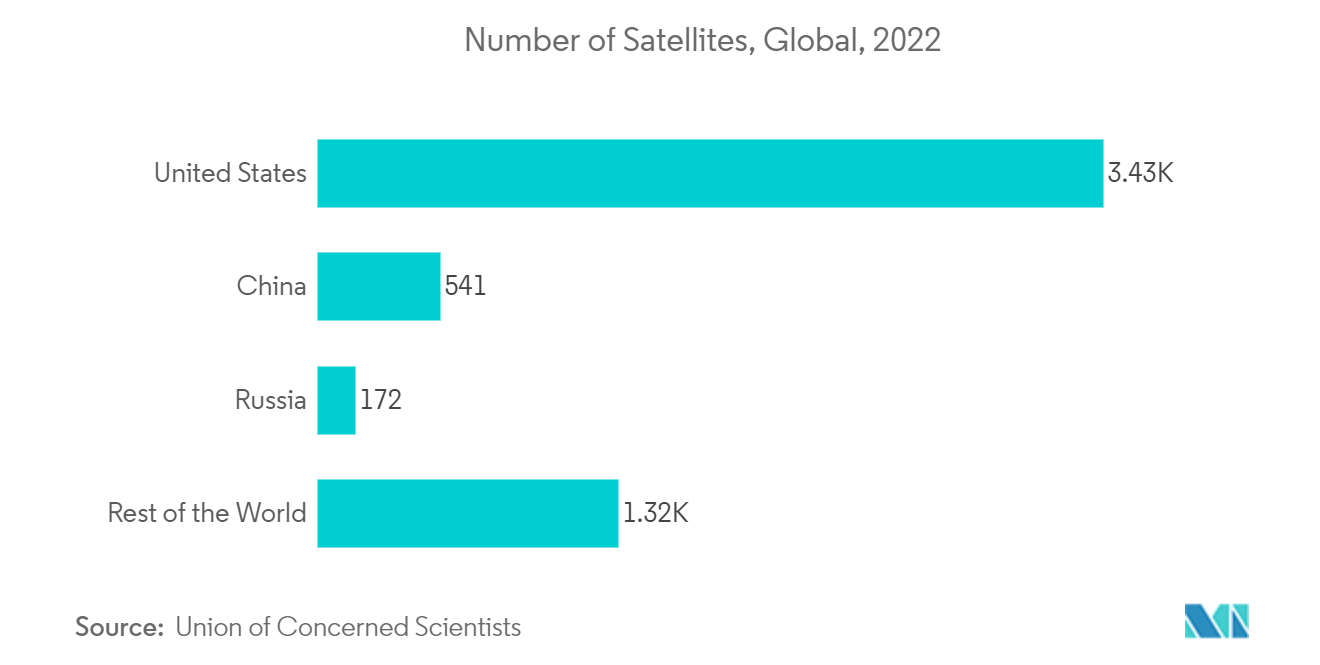
Asia-Pacific to Witness the Significant Market Growth
- Due to the rising use of waterways for transportation, the increasing government initiatives, and the expanding use of satellite communication, the Asia-Pacific region (predominantly in India, China, Japan, Malaysia, and Singapore) is anticipated to be the fastest-growing segment in the maritime analytics market. In addition, the region's abundance of significant solution and service companies may foster market progress in Asia-Pacific.
- According to the Ministry of Transport of China, in May 2022, container throughput at China's coastal ports was about 22.3 million TEUs, an expansion of 7% over the previous month. Shanghai Port is the largest container seaport in China, processing about 47 million TEUs previously. Such an increase in container ships is expected to drive the market.
- According to the Broadband India Forum, the new standard for Interface Requirements for Communication & Broadcast Networks for fixed-satellite service-FSS/broadcasting satellite service-BSS (mandatory technical requirements) may authorize the ground segment very-small-aperture terminal (VSAT) participants to take advantage of the latest SATCOM technologies (BIF).
- As per the Ministry of Ports, the Deendayal port in India handled 17.5% of total cargo recently. Also, India had 224 ports last year. There was an increase in the total number of ports, especially across the South Asian country, with 7 additional minor ports added to the list. According to IBEF, approximately 95% of India's merchandise trade is done through sea ports. The country is one of the most significant peninsulas in the world, with a coastline of 7,516.6 km and 200 major and non-major ports. Hence, the rising number of ports in the region is creating a requirement for monitoring shipping-related activities, which may fuel the growth of the Asia-Pacific satellite communication market.
- Further, in December 2022, Nelco, a member of the Tata Group, applied for the Global Mobile Personal Communication by Satellite (GMPCS) license, making it the fourth company in India to do so. This action indicates increased interest in a newly emerging market with substantial growth potential. The government has so far granted licenses to Elon Musk-owned SpaceX and Bharti Group-backed OneWeb, as well as the satellite division of Reliance Jio Infocomm.
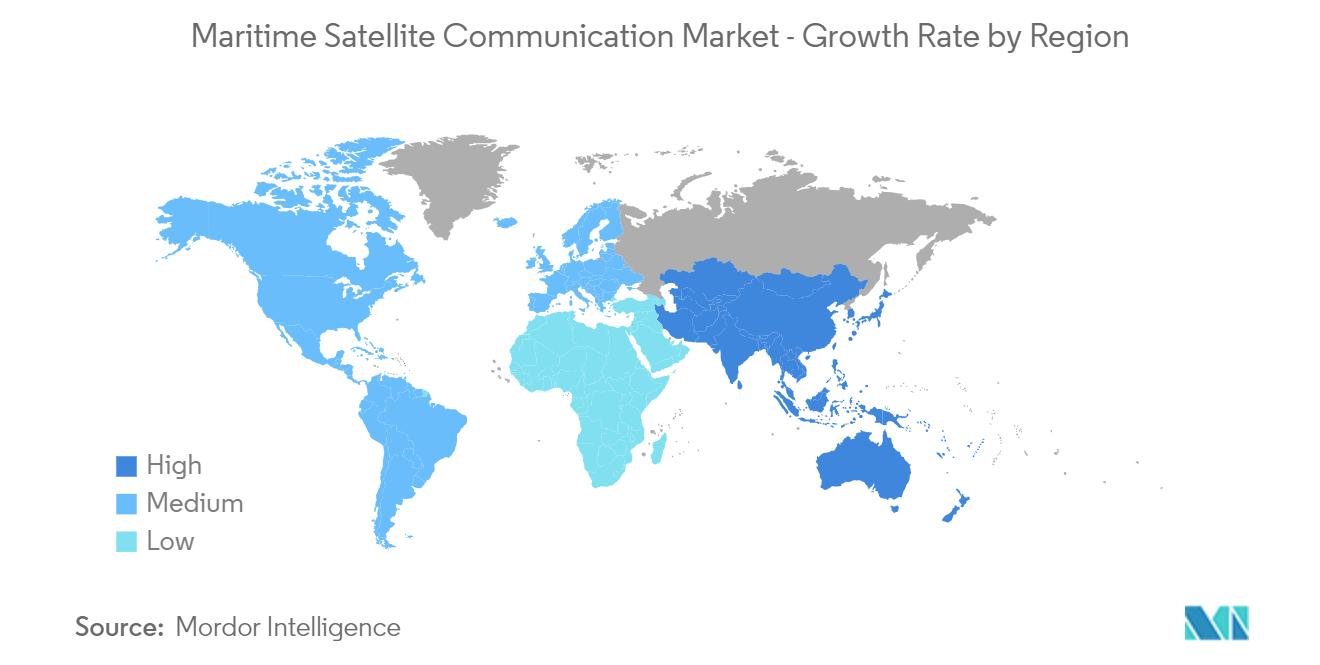
Maritime Satellite Communications Industry Overview
The maritime satellite communication market is favorably competitive with several players. In terms of market share, few of the major players currently dominate the market. These major players, with a prominent market share, focus on developing their customer base across foreign countries. These corporations leverage strategic collective initiatives to increase their market share and profitability.
- October 2022 - AXESS Networks and Viasat joined a strategic partnership to expand maritime services globally, which expect and need high-performing internet at sea. Viasat brings robust offshore internet services within a precise maritime plan.
- August 2022 - KVH partnered with the Hellenic Broadcasting Corporation (ERT) to benefit Greek seafarers with native content through KVH Link, improving the content service concentrated on a large segment of the commercial maritime crew population. The new partnership with ERT includes video and audio content available to seafarers directly on vessels enjoying KVH Link. Video content contains a one-hour news bulletin broadcast daily, keeping Greek seafarers updated with their experiences in Greece.
Maritime Satellite Communications Market Leaders
Inmarsat Group Limited
Marlink SAS (Providence Equity Partners)
KVH Industries Inc.
Speedcast
NSSL Global Limited
*Disclaimer: Major Players sorted in no particular order
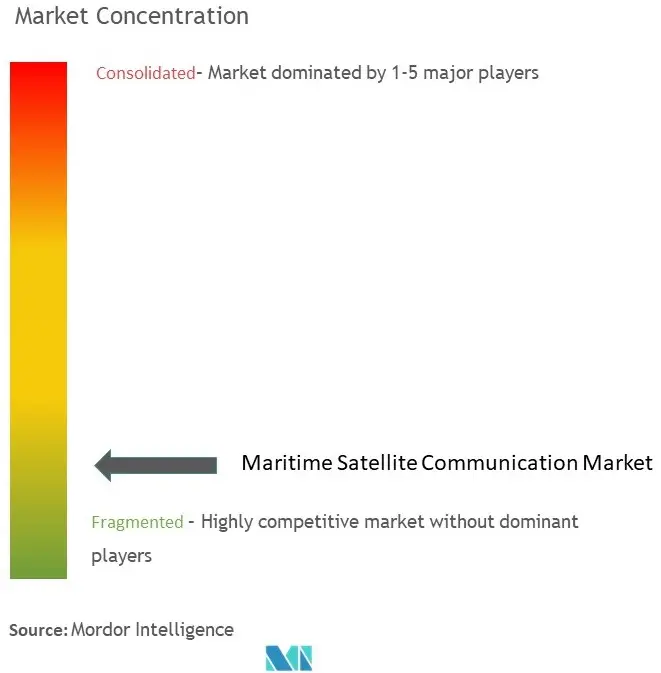
Maritime Satellite Communications Market News
- September 2022 - NSSLGlobal launched its latest VSAT IP@SEA on-demand customized connectivity packages. Customers can use its brand-new customized connectivity packages, which offer two excellent options to fulfill users' data needs. Operators can reserve committed bandwidth by the hour using the On-Demand Bandwidth Streaming service. With its range of customizable containers that can reach speeds of up to 150 Mbps, these services may give customers further control and independence over their service and bandwidth.
- July 2022 - KVH introduces KVH ONE Hybrid Network and groundbreaking TracNet Terminals. Innovative terminals feature integrated satellite, cellular, and Wi-Fi technology with intelligent, automatic switching to connect boats to the best-known communication option for fast, reliable connectivity at the ocean and the dock.
Maritime Satellite Communications Market Report - Table of Contents
1. INTRODUCTION
1.1 Study Assumptions and Market Definition
1.2 Scope of the Study
2. RESEARCH METHODOLOGY
3. EXECUTIVE SUMMARY
4. MARKET INSIGHTS
4.1 Market Overview
4.2 Industry Attractiveness - Porter's Five Forces Analysis
4.2.1 Threat of New Entrants
4.2.2 Bargaining Power of Buyers
4.2.3 Bargaining Power of Suppliers
4.2.4 Threat of Substitute Products and Services
4.2.5 Intensity of Competitive Rivalry
4.3 Technology Snapshot (Ka, Ku, and C Bands, Size of Terminals, Application Notes, and Penetration)
4.4 Impact of Macroeconomic Trends on Maritime VSAT and Allied Markets
5. MARKET DYNAMICS
5.1 Market Drivers
5.1.1 Increasing Need for Connectivity for Crew Welfare and Operations
5.1.2 Launch of High-Throughput Satellite (HTS) satellites
5.2 Market Restraints
5.2.1 Lack of Awareness About the Advanced Satellite Service Market
5.2.2 Reliance on High-cost Satellite Equipment
6. MARKET SEGMENTATION
6.1 By Type
6.1.1 Mobile Satellite Communication or Mobile Satellite Services (MSS)
6.1.2 Very Small Aperture Terminal (VSAT)
6.2 By Offering
6.2.1 Solution
6.2.2 Service
6.3 By End-User Vertical
6.3.1 Merchant (Cargo, Tanker, Container, Bulk Carrier etc.)
6.3.2 Offshore Rigs and Support Vessels
6.3.3 Passenger Fleet (Cruise, Ferry)
6.3.4 Leisure (Yachts)
6.3.5 Finishing Vessels
6.4 By Geography
6.4.1 North America
6.4.2 Europe
6.4.3 Asia Pacific
6.4.4 Rest of the World
7. COMPETITIVE LANDSCAPE
7.1 Company Profiles*
7.1.1 Inmarsat Group Limited
7.1.2 Marlink SAS (Providence Equity Partners)
7.1.3 KVH Industries Inc.
7.1.4 Speedcast International
7.1.5 NSSL Global Limited
7.1.6 Cobham Satcom
7.1.7 Iridium Communications Inc.
7.1.8 Thuraya Telecommunications Company
7.1.9 Hughes Network Systems LLC
7.1.10 Viasat Inc.
8. INVESTMENT ANALYSIS
9. FUTURE OF THE MARKET
Maritime Satellite Communications Industry Segmentation
Marine communication involves ship-to-ship and ship-to-shore communication. Over the years, how seamen communicate has changed drastically. Previously, semaphores and flags were a primary form of communication for ships out at sea. Maritime satellite communication comprises a range of communication service offerings delivered mainly through Ku-band, L-band, and Ka-band frequency-based satellite communication services, which help communication worldwide.
The studied market is Segmented by types, such as Mobile Satellite Communication or Mobile Satellite Services(MSS) and Very Small Aperture Terminal (VSAT), among Solution and Services offerings. The study also comprises various end-user verticals such as Merchant, (Cargo, Tanker, Container, Bulk Carrier), Offshore Rigs and Support Vessels, Passenger Fleet (Cruise, Ferry), Leisure (Yachts), and Finishing Vessels in multiple geographies. The market sizes and predictions are provided in terms of value in USD for all the above segments. The impact of macroeconomic trends on the market is also covered under the scope of the study. Further, the disturbance of the factors affecting the Market's evolution in the near future has been covered in the study regarding drivers and constraints. The market sizes and predictions are provided in terms of value in USD for all the above segments.
| By Type | |
| Mobile Satellite Communication or Mobile Satellite Services (MSS) | |
| Very Small Aperture Terminal (VSAT) |
| By Offering | |
| Solution | |
| Service |
| By End-User Vertical | |
| Merchant (Cargo, Tanker, Container, Bulk Carrier etc.) | |
| Offshore Rigs and Support Vessels | |
| Passenger Fleet (Cruise, Ferry) | |
| Leisure (Yachts) | |
| Finishing Vessels |
| By Geography | |
| North America | |
| Europe | |
| Asia Pacific | |
| Rest of the World |
Maritime Satellite Communications Market Research FAQs
How big is the Maritime Satellite Communication Market?
The Maritime Satellite Communication Market size is expected to reach USD 6.47 billion in 2024 and grow at a CAGR of 11% to reach USD 10.91 billion by 2029.
What is the current Maritime Satellite Communication Market size?
In 2024, the Maritime Satellite Communication Market size is expected to reach USD 6.47 billion.
Who are the key players in Maritime Satellite Communication Market?
Inmarsat Group Limited, Marlink SAS (Providence Equity Partners), KVH Industries Inc., Speedcast and NSSL Global Limited are the major companies operating in the Maritime Satellite Communication Market.
Which is the fastest growing region in Maritime Satellite Communication Market?
Asia-Pacific is estimated to grow at the highest CAGR over the forecast period (2024-2029).
Which region has the biggest share in Maritime Satellite Communication Market?
In 2024, the North America accounts for the largest market share in Maritime Satellite Communication Market.
What years does this Maritime Satellite Communication Market cover, and what was the market size in 2023?
In 2023, the Maritime Satellite Communication Market size was estimated at USD 5.83 billion. The report covers the Maritime Satellite Communication Market historical market size for years: 2019, 2020, 2021, 2022 and 2023. The report also forecasts the Maritime Satellite Communication Market size for years: 2024, 2025, 2026, 2027, 2028 and 2029.
Maritime Satellite Communications Industry Report
Statistics for the 2023 Maritime Satellite Communications market share, size and revenue growth rate, created by Mordor Intelligence™ Industry Reports. Maritime Satellite Communications analysis includes a market forecast outlook to 2029 and historical overview. Get a sample of this industry analysis as a free report PDF download.
